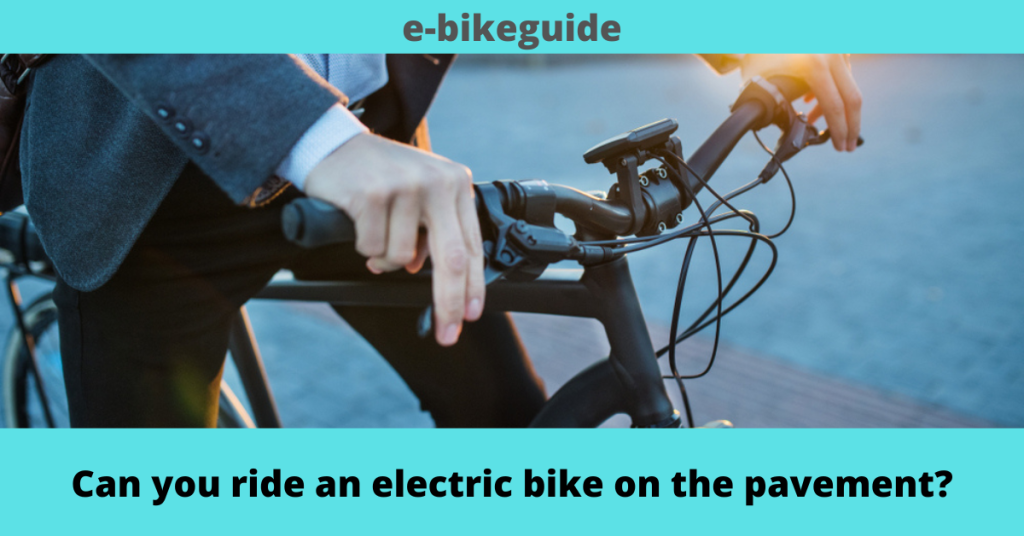Can you ride an electric bike on the sidewalk?

A German named Baron Karl von Drais introduced the two-wheeled cycle in 1817. It did not have pedals or brakes, only two wheels, and a handlebar. The rider has to kick the road to propel the bicycle. It soon lost its limelight because it was not safe for the rider without the controller.
Later in 1860, three French inventors introduced the pedal to the bicycle. It gained popularity among the people, and in the coming years, tires, brakes, and chains were introduced to bicycles. Century later, traditional bikes followed the same model.
In this era, where electric vehicles are gaining popularity, electric bikes are in vogue too. Electric bikes got the patent by the end of the 19th century. It was a time the machines were popular and in demand. Motors and batteries were larger and weighed too high. They were also costly, and for these reasons, they did not gain popularity among the people.
In a century, motors and batteries were made smaller, which was the time for an electric bike to shine again. The electric bike soon gained recognition among the people by the end of the 20th century, and two decades later, its demand is still rising.
In these two decades, many manufacturers have designed and developed different types of bikes, including various features. With so many types of electric bikes on the market, they can be classified into three main classes, they are:
-
Class 1
These electric bikes have only pedal assist. You can choose to ride your electric bike with or without pedal assist. You can choose among the levels of pedal assistance you want to ride your electric bike.
The maximum speed you can propel in this electric bike is 20mph.
These bikes come under the classification of bicycles, and you can ride them in bicycle lanes.
-
Class 2
These electric bikes have throttle and pedal assist. You can choose to ride your electric bike with pedal assist, using the throttle, or both.
You can go up to 20mph on this electric bike.
These bikes, too, come under the bicycle, and you can ride them in the bicycle lane.
-
Class 3
These electric bikes will have the throttle or will be without throttle.
The maximum speed you can ride in this electric bike is 28mph in this electric bike.
These bikes come under the classification of motorcycles and can not ride in the bicycle lane.
Electric bike laws vary from state to state; know your state rules before you take them on the road or the bicycle lane. Normally, you can ride class 1 and 2 electric bikes, whereas you can ride a traditional bike. And you can ride class 3 electric bikes normally on the road. But due to different laws in different states, check the laws of your state before you take it to the road.
Can you ride electric bikes on the pavement?

Electric bike laws vary from state to state; therefore, you cannot answer this question in one word. It all depends on the country you live in and the laws of your state or district. Before taking your electric bike, know the law of that particular area so that you won’t face any legal charges.
Class 1 and 2 electric bikes are similar to a traditional bicycles. The maximum speed can be 20mph. It is the same speed limit as a traditional bike. Therefore in many states and countries, you can take these electric bikes anywhere bicycles are allowed.
Before considering the rules of riding the electric bike on the pavement, we have to know if that particular country or state allows any vehicles on the pavement. Some countries do not allow wheels on the pavement; surely, they will not allow electric bikes. But some countries allow only traditional bicycles to use the pavement, while in others, any vehicles can use the pavement. So in places where they allow the traditional bicycles on pavement, you can take your class 1 and 2 electric bikes.
Class 3 electric bikes have mixed rules and regulations. Sometimes they will allow using the main road, and sometimes they cannot be seen on the roads. Usually, bicycle lanes are restricted for class 3 electric bikes due to their speed limit. Therefore, in places where they allow only traditional bikes on the pavement, Class 3 electric bikes will not be able to use the pavement.
Electric mountain and hunting bikes sometimes exceed the speed limit, and the features vary from class 3 electric bikes. These bikes are informally classed as class 4 electric bikes. These bikes are allowed in places any motor and non-motorized vehicles are allowed. But check the area’s law as the law might not permit these bikes on roads. These bikes will probably not be approved for using the pavement as to the pavements.
Varying legal laws that are enforced on electric bikes.

Electric bikes Ste gaining popularity among developed countries and developing countries. As the government joins hands with environmentalists, encourage using electric vehicles instead of fueling automobiles. Due to their environment-friendly nature and the ability to ride through the traffic, people favor electric bikes.
People have started using it for commuting, trekking, fitness training, and recreation. With its many features, it contains user-friendly electric bikes. It lets you connect your smartphone and use GPS, tracking apps, navigation, etc. Electric bikes let you go on adventures to new and far areas with less energy.
These bikes are of many types and usually are classed under three, as we now know. These classes of electric bikes have varying legal regulations in different states. Sometimes, even cities have different rules on electric bikes.
The States have defined electric bikes under the classification of traditional bikes, mopeds, or scooters. These classifications are based on three classes of bikes or the state’s definition. Some States have no definition at all.
Age restrictions vary from state to state and country to country. Class 1 electric bikes use only pedal assist; usually, they have no restrictions. These restrictions apply only to class 2 and 3 electric bikes. Some States have no age restrictions while others have age restrictions: 14, 15, and 16 with or without the supervision of an adult depending on the state laws.
Registration, license, and insurance are important if the state has defined electric bikes as mopeds or scooters. Mostly class 1 electric miles are classified as a traditional bicycle, and in states where the electric bike has classified as a traditional bike, there will be no pressure on this. An insurance policy is a financial aid you will receive if your vehicle met with an accident or robbery.
Safety Considerations

With varying laws in different states, riders should ensure the safety of the public and the passengers with their safety. In the states where there are no restrictions on the helmet, it is advised to wear it. Helmets are shields that protect our heads in times of an accident. Cities which has high traffic are inclined to accidents. Therefore, the helmet will be insisted on by the riders. Depending on the state where you live, helmet restrictions will vary from other states. Some have no restrictions, while others enforce this on all riders and passengers on all classes of bikes.
Insurance can come in as a savior in unfortunate situations. Even if your electric bikes need no insurance, you can still apply for one. It will help you overcome financial loss if your bike or battery is stolen or in an accident. Or you can add your electric bike to the contents of your home insurance policy.
You must make yourself visible when using busy roads, especially at night. As the electric bike is a new concept, motorists have not yet reckoned the electric bikes and their speed. Wear bright and reflective clothing to make your presence known. Use bright flashing headlights and taillights at night to prevent tragic accidents.
Road rules apply if you ride your electric bike on the roads. You should abide by them and follow them. It would be best if you stop at the red lights, use hand movements when changing direction and have a safe distance from other vehicles.
Road rules are always changing, and electric bike users should always have knowledge of the new rules and obey them. Pedestrians and other motors are to be regarded.
Common rules to follow when riding an electric bike.

Governments impose rules and regulations to avoid accidents and provide everyone with a safe riding experience. Electric bikes have motors, and the speed limits vary. Therefore, they are classified, and different pathways are allowed for each class. Whatever class of electric bike you ride, you should follow the rules of your local residences. It will not only save you from legal issues but prevents unfortunate events.
Do not try your luck if your electric bikes are not allowed in motorways or bicycle lanes. Try it off-road. Here are the common rules for all electric bikes in many states and countries:
- Many states or countries do not allow children to ride class 2 and 3 electric bikes, but you can try class 1 electric bikes. You must be at least 13 years old to try an electric bike.
- You can ride class 1 and 2 bikes on bicycle lanes, but not class 3 electric bikes.
- If the electric bike rider is below 17, he should wear a helmet.
- The maximum weight of the motor should be 750 watts. It should not exceed this level.
- Some States need your electric bike to register and have a license, check the laws, and register if it is the rule of your state or country.
- You should follow the speed limit signs on the roads.
- Some narrow roads are off-limit for electric bikes, know them and do not take your electric bike there.
- State laws differ regarding the trails and sidewalks. Check the rules before taking your electric bike there.
- Some States demand you display the class of your electric bike with the speed limit and motor wattage, display them if your state orders it.
These rules are for the safety of the rider and pedestrians. Rules vary from state to state and country to country. Therefore the laws might be different if you take your electric bike out of your state. Know the rules of that state on electric bikes before you take your bike there.
Future of electric bikes

States and countries are recognizing electric bikes. And with the new features and the many benefits it has on the riders and the environment, they will flood the motorways in the future, replacing the motor vehicles. Electric bike manufacturers focus on the rider’s safety and build many safety technologies.
Batteries and motors add more weight to electric bikes. These will be smaller and lightweight in the future. Batteries will have a longer lifespan and take a short time to charge. It will allow us to go on longer adventures. And most importantly, we can expect the price to go down a little so that everyone can afford it.
Electric bikes can connect to your smartphone and use apps. We can expect more technologies to protect the rider and the bike. More apps that let you track the bike and use navigations.
Electric bikes are a faster and cheaper way to commute compared to other automobiles. When manufacturers introduce solar charging, they will get cheaper. But with the batteries being combustible and more prone to heat, this issue will be looked into first. Manufacturers are developing heat-resistant batteries, and we can hope to have a safe summer ride in the future.
Disposing of the dead battery is the main concern of many electric bike owners. Though electric bikes are friendly, the batteries are not. Manufacturers of electric bike batteries are trying to manufacture batteries using more environmentally friendly materials. And recycle the battery.
Many countries have highways dedicated to only bikes. These are a safe way of riding a bike without being a disturbance to other motor vehicles. We can expect this infrastructure to reach other countries within a few years.
Conclusion

Two decades before, electric bicycles were reintroduced with smaller batteries and motors, with lightweight. It made electric bikes more popular, and demand for them is still rising. With various manufacturers inducing different features on electric bikes, many types of electric bikes have arrived on the market. These electric bikes are classified differently in countries and states. The most common classification is the classes of bikes that use the speed and use of throttle with pedal assist in differentiating among the classes.
These classes of bikes law on the roads vary. Class 1 and 2 bikes are mostly classified as traditional bikes. And so they can use the bicycle lanes and ride these electric bikes wherever the traditional bikes can. With their maximum speed limit of 20mph, in some states and countries, they can not ride on motorways. Class 3 bikes have a maximum speed limit of 28mph and usually fall under the classification of motorcycles. In some states, they will be allowed on motorways while others are not. But bicycle lanes are restricted due to the speed limit.
Pavements in many countries are only for the people to walk and do not allow any vehicles, even traditional bikes. You will not be able to ride electric bikes on pavements in these places. In countries and states that allow traditional bicycles to use the pavement, you can take your electric bike on the pavement, but not the class 3 electric bikes. In places that allow motorcycles, you can take your electric bike too. But this is in rarity.
Electric mountain bikes and hunting bikes are different from class 3 electric bikes. They are mostly restricted on motorways, and you can use off-roads. Sometimes, they are allowed to use the roads. But remember to check your laws before you are on the road with your electric hunting or Mountain bikes.
